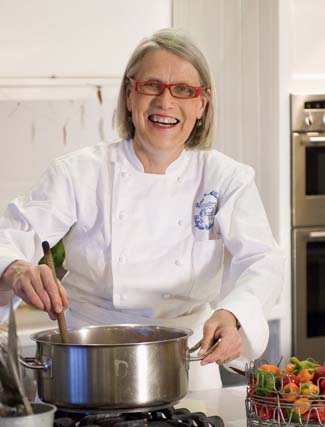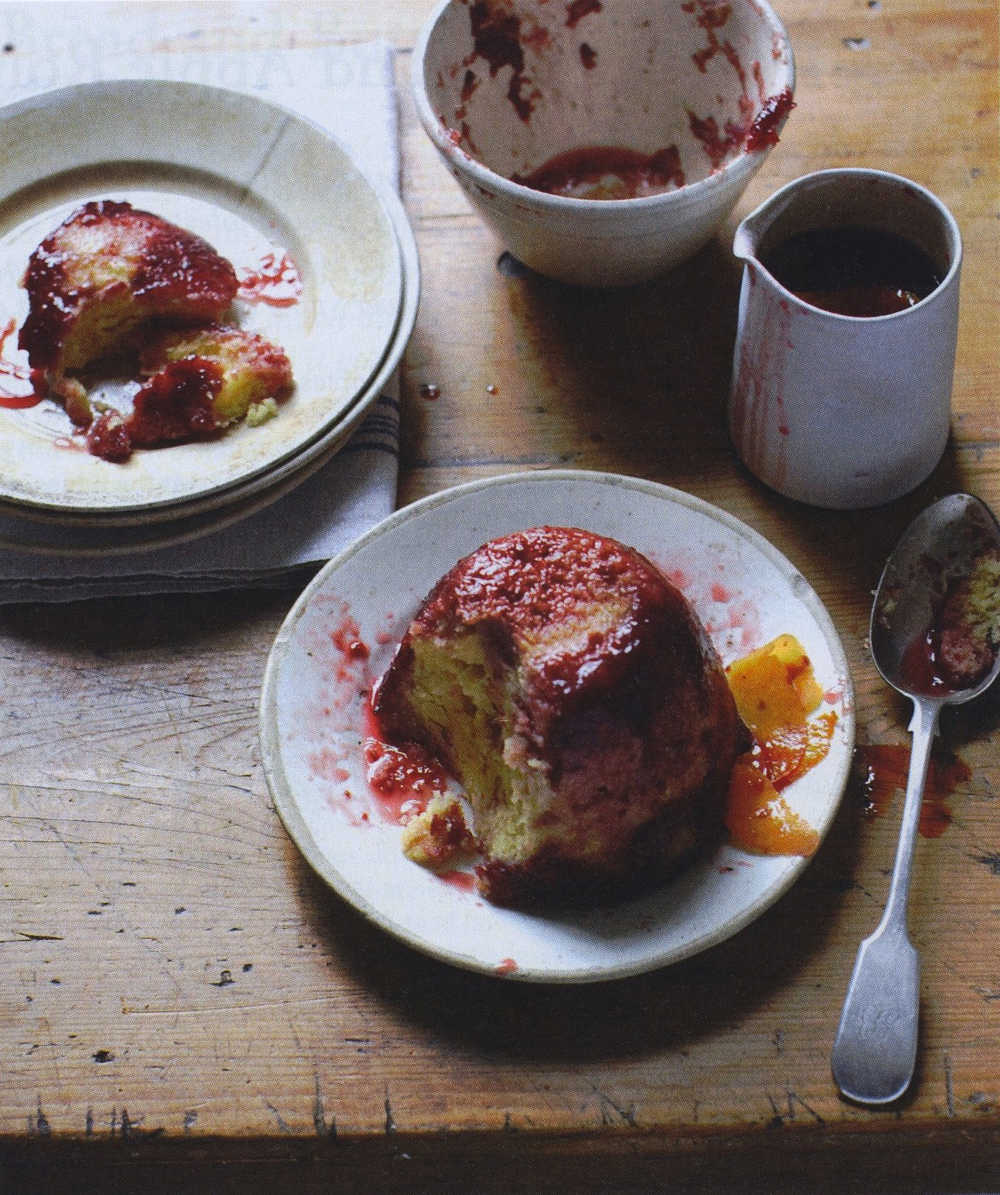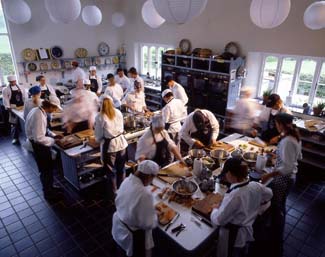The Darina Allen Column

Once more on the war path to get us to take back control of what we eat, Darina recalls George Orwell’s prophetic words in ‘The Road to Wigan Pier’ (1937), “…we may find in the long run that tinned /processed food is a deadlier weapon than the machine gun”.
Before the Christmas holidays every magazine, newspaper, food programme and TV ad was shamelessly luring us into temptation, encouraging us to over spend and over indulge in a myriad of different ways.
It was hard to resist and of course many of us succumbed. Then the day of reckoning came. Now it’s all about lean, keen and frugal, instead of tempting food supplements in newspapers, there are diet supplements each promising miracles.
Slim and trim in 28 days….The five pound weight loss trick that works…How to lose weight and keep it off…..yeah, yeah, yeah….How gullible are we, whoever checks the results? Cookbooks that promise to make you glow and make you beautiful vaporise off the shelves as we clutch at straws. One super food after another rises and falls.
At last there’s the beginnings of a backlash - after countless hopes have been raised and dashed, a badly needed note of scepticism is being introduced.
So could it really be that after all the false promises the answer is quite simply a balanced diet of fresh natural food in season and everything in moderation? How undramatic and boring does that sound – yet it is unquestionably true. I’ve never been on a diet in my life and I don’t intend to start now but there are some things I really do feel strongly about.
Eat as much organic and naturally produced food as possible. In the words of George Orwell in 1937 when he wrote ‘The Road to Wigan Pier’, “we may find in the long run that tinned food/ processed food is a deadlier weapon than the machine gun”.
• Eliminate processed food entirely from our diets. We can no longer say we don’t know the damage they are doing to both our essential mental and physical health.
• Eat less meat but better quality and lots of unsprayed vegetables and fruit that have been grown in rich fertile soil not hydroponically.
• We need to reduce our sugar intake by at least 50% NOW.
Nowadays, according to most recent research, 1 in 2 of us will suffer from some form of cancer. I was brought up with the understanding that food should be our medicine and that if we didn’t put resources into the food on the table we’d give it to the doctor or chemist.
How true is that – of course we are all insanely busy but there are few things more important than the quality of the food we put on the table. I’m not talking fancy – I’m just talking real simple food that comforts and nourishes.
We have got to take back control of our food choices from the multinational corporations who can’t be expected to have our best interests at heart. Their sole concern is to make the maximum profit for their shareholders, not our personal health.
So dump all those breakfast cereals and go back to porridge, ban all fizzy drinks and rediscover water. We used to have homemade lemonade everyday on our lunch tables here at the school but now it’s water kefir – a simple fermented drink that can be flavoured with anything from lemon to loganberries and lots of fresh herbs. It’s exceedingly good for your gut flora and the students love it.
We’ve got to reintroduce cooking classes back into the school curriculum from ‘baby infants’ upwards. It could single-handedly help to change our eating habits and up skill the next generations in such a way that they can take back control of what they eat.
RECIPES
Water Kefir
With Water Kefir you can turn sugared water into one of the most vibrant, probiotic-rich drinks you can make at home!
2 tablespoons (2½ American tablespoons) water kefir grains
2-3 tablespoons (2½ - 4 American tablespoons) organic raw cane sugar
4 unsulphered dried apricots or other dried fruit.
Approximately 1 litre (1 3/4 pints/scant 4 cups) of water – must be free of chemicals
Slice of unwaxed lemon
It is important not to use any metal utensils or brewing vessels while making Water Kefir.
Stir the sugar into approximately 250ml (9fl oz/generous 1 cup) of hot water until it dissolves, then add remainder of cold water and allow it to cool to room temperature.
Place the water kefir grains into a 1litre jar, pour in the cooled sugar water, and drop in the dried fruit.
Cover the jar loosely with a lid, or with a cloth secured with a rubber band to allow air in but to prevent stray debris from spoiling your water kefir. Allow the water kefir to ferment for 2 to 3 days. The longer it ferments, the drier and less sweet it will become.
When the water kefir acquires a flavour that suits you, strain it using a plastic strainer into a jug. Discard the dried fruit (or eat it) but reserve the water kefir grains which can be immediately reused or stored.
While the water kefir can be enjoyed as it is, after its initial fermentation, you can also ferment it a second time. Secondary fermentation (see below) allows you to flavor the water kefir, and the secondary fermentation process, which occurs in a tightly capped bottle allows carbon dioxide to develop, producing a fizzy water kefir.
Transfer the bottles of water kefir to the fridge to slow down fermentation and enjoy
Second Fermentation
After transferring you water kefir into a bottle add a handful of one of the following to your taste.
• Fresh or Frozen Raspberries
• Fresh or Frozen Strawberries
• Other soft fruit
• 5 – 6 small pieces of Crystallised Ginger.
• Several crushed mint leaves and juice of 1 Lemon
Leave to ferment for another 12 – 24 hours with a lid on. It’s a good idea to release pressure every so often, particularly if your kitchen is warm, as secondary ferments have been known to explode! Keep tasting to understand when your ferment is ready to your liking.
Caring for your Kefir Grains
Water Kefir grains are alive being a Scoby (Symbiotic colony of bacteria and yeasts) and therefore require looking after to ensure they produce the best kefir for you.
Occasionally it is beneficial to give your grains a mineral feed.
Jerusalem Artichoke Soup with Crispy Croutons
Serves 8-10
Jerusalem artichokes are a sadly neglected winter vegetable. They look like knobbly potatoes and are a nuisance to peel, but if they are very fresh you can sometimes get away with just giving them a good scrub. Not only are they a smashing vegetable but they are also delicious in soups and gratins. They are a real gem from the gardeners point of view because the foliage grows into a hedge and provides shelter and cover for both compost heaps and pheasants!
Nutrition: Jerusalem Artichokes are a very important source of inulin which enhances the growth of beneficial bacteria in our systems. Particularly essential after a course of antibiotics.
50g (2oz/1/2 stick) butter
560g (1¼ lb) onions, peeled and chopped
1.15kg (2 ½ lb) Jerusalem artichokes, scrubbed, peeled and chopped
salt and freshly ground pepper
1.1L (2 pints/5 cups) light chicken stock
600ml (1 pint/2 1/2 cups) creamy milk approx.
Garnish: freshly chopped parsley; crisp, golden croutons
Melt the butter in a heavy bottomed saucepan, add the onions and artichokes. Season with salt and freshly ground pepper, cover and sweat gently for 10 minutes approx. Add the stock and cook until the vegetables are soft. Liquidise and return to the heat. Thin to the required flavour and consistency with creamy milk, and adjust the seasoning.
Serve in soup bowls or in a soup tureen. Garnish with chopped parsley and crisp, golden croutons.
Note: This soup may need more stock depending on thickness required.
 Jam Pudding (from Irish Traditional Cooking, revised edition)
Jam Pudding (from Irish Traditional Cooking, revised edition)
This was one of our favourites, we raced home from school for lunch even faster when we knew Mummy was cooking a steamed jam pudding, a warm and comforting winter pudding. Serves 4
110g (4oz) butter, at room temperature
110g (4oz) caster sugar
2 eggs, free-range if possible
few drops of pure vanilla essence
170g (6oz) plain white flour
½ teaspoon baking powder
about 1 tablespoon milk or water
3 or 4 tablespoons homemade raspberry jam
Raspberry Jam Sauce
4–6 tablespoons homemade raspberry jam
rind and juice of ½ lemon
150ml (¼ pint) water
sugar, to taste
12.5cm (5in) pudding bowl
Cream the butter, add the caster sugar and beat until white and creamy. Whisk the eggs with the vanilla essence and beat, a little at a time, into the creamed mixture. Stir in the flour and baking powder and add a little milk or water if necessary to make a dropping consistency.
Grease your pudding bowl. Spread raspberry jam over the bottom and sides. Carefully spoon the cake mixture into the bowl. Cover with pleated greaseproof paper, tied on firmly, and steam the pudding for about 1½ hours.
Meanwhile, make the raspberry jam sauce. Heat the jam with the water, add the lemon rind and juice and sweeten with a little extra sugar if necessary.
Turn the pudding on to a hot dish and serve with the sauce and lots of softly whipped cream.
Coming up soon at Ballymaloe Cookery School:
Cooking For A Farmer's Market Stall | starts Wednesday April 6th | 2.5 day course
Start Your Own Cafe or Teashop | starts Monday April 11th | 5 day course
Perfecting Pastry | starts Monday April 18th | 2.5 day course
Cooking with Spices | starts Wednesday April 20th | 2.5 day course
Kerrygold Ballymaloe Lifest LitFest (May 20th-22nd 2016): Tickets are on sale now. They can be purchased at http://www.litfest.ie/ or at the Box Office 021 464 5777. There is a fantastic line-up of speakers this year, including Francis Mallman from Argentina; Eric Werner & Mya Henry from Mexico's Hartwood; Claire Ptak of Violet Bakery in London; wine experts Jancis Robinson and Hugh Johnson, to name just a few.
'30 Years at Ballymaloe' - Bord Gáis Avonmore Cookbook of the Year 2013
Good Food Ireland Cookery School of the Year 2012/2013
***
 Once again, the Ballymaloe Cookery School in East Cork has a great programme of cookery courses for all interests and abilities running throughout 2016. Ranging from a relaxing visit to sit in on an afternoon cookery demonstration to a week long ‘Intensive Introductory Course’.
Once again, the Ballymaloe Cookery School in East Cork has a great programme of cookery courses for all interests and abilities running throughout 2016. Ranging from a relaxing visit to sit in on an afternoon cookery demonstration to a week long ‘Intensive Introductory Course’.
Sitting in the middle of a 100 acre organic farm the Ballymaloe Cookery School provides its students not only with a life skill learnt under the expert tutelage of their very capable teachers but also a place to relax and unwind from the stresses and strains of normal everyday life. The cottage accommodation available onsite for residential courses consists of a collection of delightful converted outbuildings which have been transformed over the years by the Allens, and other accommodation is available locally for the short courses.
www.cookingisfun.ie






There are currently no comments
Leave a comment
Not a member? Register for your free membership now!
Or leave a comment by logging in with: